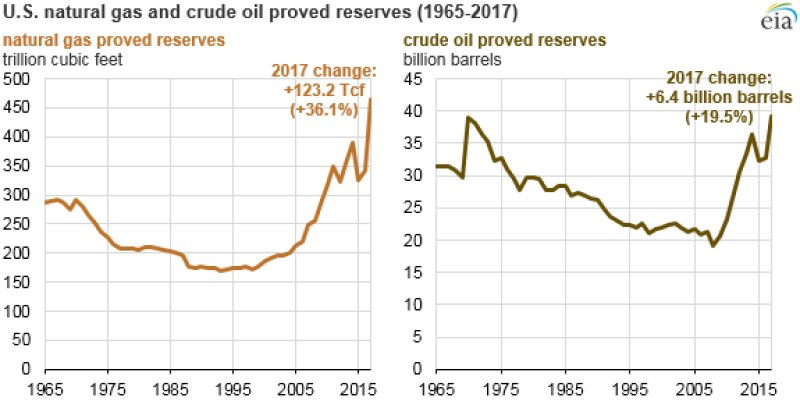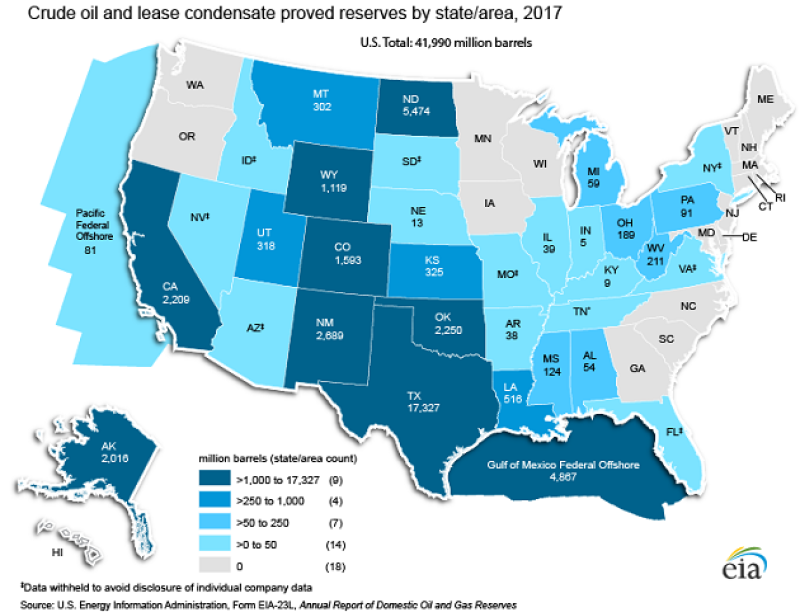US proved reserves of crude oil and natural gas reached all-time highs at yearend 2017, as higher commodity prices encouraged more drilling and expanded the scope of what operators deem economically recoverable.
Proved oil reserves for the year totaled 39.2 billion bbl, jumping 19.5% from a year earlier and edging higher than the 1970 record, according to an annual report from the US Energy Information Administration (EIA). Accounting for lease condensate, proved reserves were just under 42 billion bbl, up 19% year-over-year.
Proved gas reserves were 464.3 Tcf, a 36.1% spike from a year earlier and well-above the 2014 all-time mark.

Owing to the unconventional boom built on horizontal drilling and hydraulic fracturing, both oil and gas totals are twice their levels compared with a decade ago.
The reported increases come as US oil and gas production continues to set records. In its November Short-Term Energy Outlook, the EIA said it expects the country’s crude output to average 10.9 million B/D in 2018 and rise to 12.1 million B/D in 2019. Gas production is forecast to average 83.2 Bcf/D this year and 89.6 Bcf/D next year.
As with production, growing reserves are, in large part, driven by a flurry of activity in the Permian Basin of West Texas and southeastern New Mexico, where operators are increasingly tapping into stacked oil formations in the Spraberry Trend and the Wolfcamp-Bone Spring Shale. Texas and New Mexico added proved oil reserves of 3.1 billion bbl and 1 billion bbl, respectively, during 2017.

The Wolfcamp-Bone Spring, along with the Haynesville-Bossier Shale that extends into East Texas, boosted Texas’s gas reserves by 26.9 Tcf, the second-largest increase after Pennsylvania, which added 28.1 Tcf on higher gas prices and further development of the Appalachian Basin’s Marcellus and Utica Shales. Louisiana, also home of the Haynesville-Bossier, added 18.4 Tcf in gas reserves.
Marcellus gas reserves jumped almost 50% in 2017 to 123.8 Tcf, the highest total of all the major shale gas plays, as lateral lengths continue to rise in the region. Toward the end of last year, operator EQT reported that it had completed a 17,400-ft lateral in the Marcellus and planned to drill 27 more wells that length or longer in the region this year.
The gains made in plays such as the Marcellus reflect the growing dominance of US shale development vs. conventional or offshore targets. Shale gas now makes up 66% of overall US gas reserves.
Wolfcamp-Bone Spring Bounty
Development of the Wolfcamp-Bone Spring took a big leap forward last year. Backed by stable oil prices, many operators sought to exploit acreage positions after either entering the play or expanding their existing holdings as part of portfolio revamps amid the downturn.
Proved oil reserves in the Wolfcamp-Bone Spring in 2017 rose 40% year-over-year to 8.3 billion bbl, vaulting it well above the Bakken-Three Forks play of the Williston Basin as the play with the most proved oil reserves. Wolfcamp-Bone Spring also became the largest oil-producing tight play last year.
Wolfcamp operators such as EOG Resources, which has 346,000 net acres in the play, are accessing more oil by drilling longer laterals, more precisely targeting oil-bearing formations, and using high-density stimulations, the EIA noted. EOG was Texas’s largest oil producer last year, according to Texas Railroad Commission data.
Average lateral lengths of Wolfcamp completed wells increased by almost 1,000 ft in 2017 to 6,100 ft, the EIA said, and they are continuing to stretch farther. In its third-quarter 2018 earnings report, EOG said its average lateral length was 7,100 ft in the Wolfcamp and 5,200 ft in the Bone Spring.
Operators are better placing those wellbores with improved real-time geosteering resulting from more capable logging-while-drilling sensors and software. And, during hydraulic fracturing, they’re adding perforation clusters to each frac stage and loading more proppant per lateral foot.
Advancements such as these helped EOG post average third-quarter 30-day initial production rates of 1,655 B/D of crude and condensate from the Wolfcamp and 1,135 B/D from the Bone Spring.

